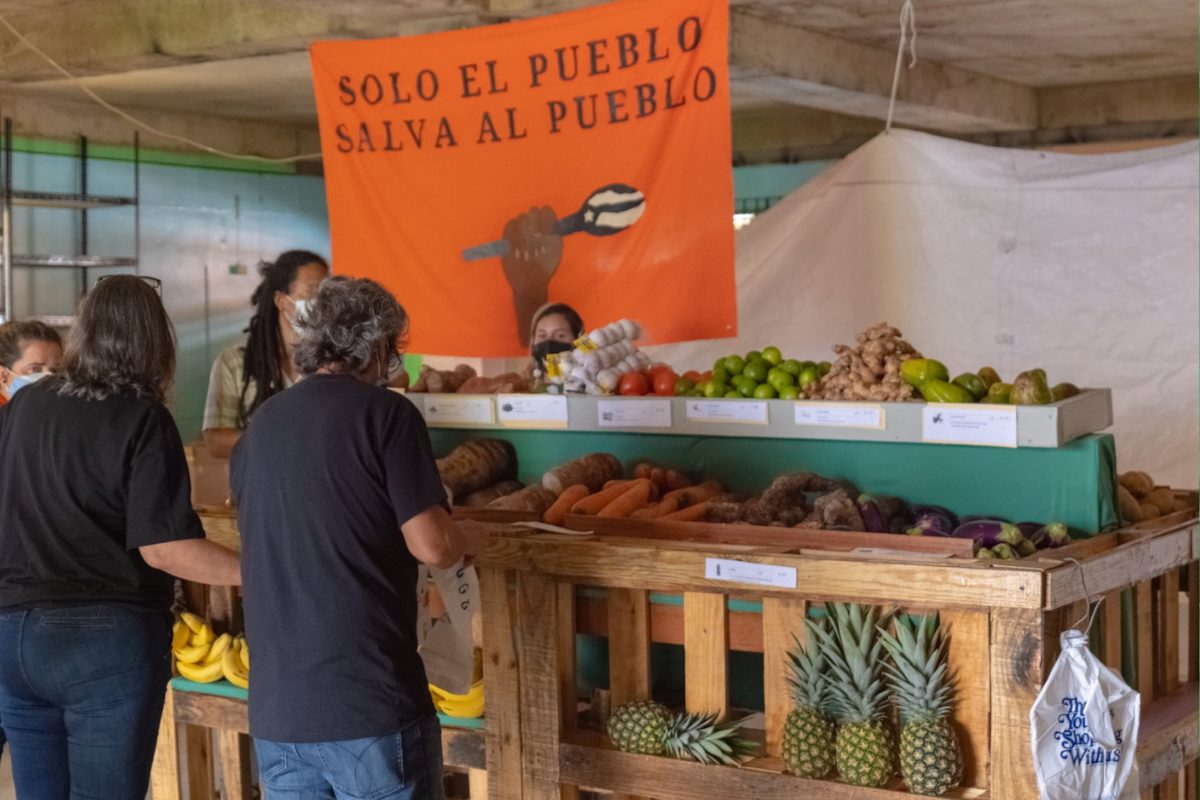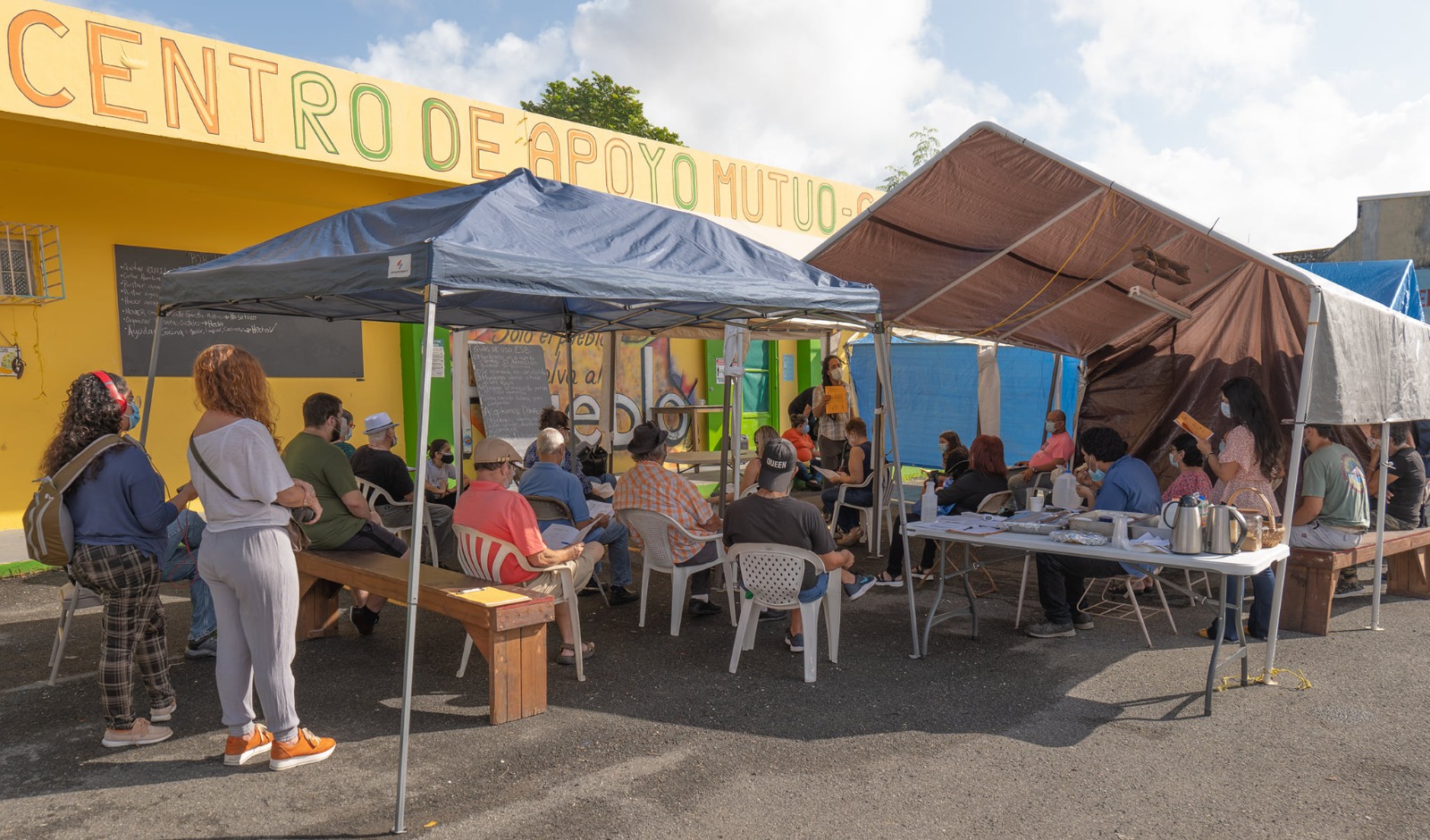

Photo courtesy of Comedores Sociales de Puerto Rico
By JULIA ROCHA, Latino USA
Five years after Hurricane Maria, we look at the history and legacy of mutual aid organizing in Puerto Rico.
CAGUAS, Puerto Rico — Walking through the heart of this city about 20 miles south of San Juan, you will notice many abandoned buildings. But if you walk into the town’s center, you may start to notice something different: a mural of dark brown hands surrounded by fruits and vegetables; a concrete building with the words “Centro de Apoyo Mutuo” painted on the front, its large parking lot lined with tulsi and sunflowers.
This is “La cuadra social,” an entire block of formerly abandoned spaces that have been repurposed by community members.


Photo courtesy of Comedores Sociales de Puerto Rico
According to studies by the Centro de Reconstrucción del Hábitat, an organization that researches abandoned spaces in Puerto Rico, one in three homes in Puerto Rico is vacant and there are thousands of closed businesses and other properties that have not been properly counted. The amount of abandoned properties has much to do with public policy on the island that has disproportionately benefited wealthy American interests over the people of Puerto Rico. Austerity policies such as drastic cuts in pensions, education, and healthcare have led to massive migration from the island in the last decade. Meanwhile, several initiatives such as Act 20 and Act 22 have provided tax exemptions for investors to move to the island.
These inequity dynamics were laid bare after Hurricane María swept through in September 2017.
Weeks after one of the worst natural disasters to ever strike the island, and facing a total lack of government aid, a group of young organizers with Comedores Sociales de Puerto Rico decided to occupy an abandoned social security building to meet their community’s needs. Although the building was in complete disrepair due to more than 30 years of it being abandoned, the community began to transform the space, turning it into a functional community kitchen that served food. The project brought the whole community together, with elders working alongside students and even young children.
Now, five years later, we follow their struggle to remain in the building, which is owned by a large American real estate company that has benefited from tax exemptions.
***
Latino USA with Maria Hinojosa, produced by Futuro Media, is the longest-running Latino-focused program on U.S. public media.



[…] post Responding With Dignity in Puerto Rico (A Latino USA Podcast) appeared first on Latino […]
[…] Following the music video, there’s a nearly-20-minute documentary titled “Aquí Vive Gente” by Puerto Rican journalist Bianca Graulau. The documentary covers the displacement of Puerto Ricans on the island, specializing in how neighborhoods have change into gentrified underneath Act 20 and 22. […]
[…] Following the music video, there’s a nearly-20-minute documentary titled “Aquí Vive Gente” by Puerto Rican journalist Bianca Graulau. The documentary covers the displacement of Puerto Ricans on the island, focusing on how neighborhoods have become gentrified under Acts 20 and 22. […]
[…] Following the music video, there’s a nearly-20-minute documentary titled “Aquí Vive Gente” by Puerto Rican journalist Bianca Graulau. The documentary covers the displacement of Puerto Ricans on the island, specializing in how neighborhoods have change into gentrified below Act 20 and 22. […]
[…] Después del video musical, hay un documental de casi 20 minutos titulado “Aquí Vive Gente” de la periodista puertorriqueña Bianca Graulau. El documental cubre el desplazamiento de los puertorriqueños en la isla, centrándose en cómo los barrios se han aburguesado bajo Hechos 20 y 22. […]
[…] Following the music video, there’s a nearly-20-minute documentary titled “Aquí Vive Gente” by Puerto Rican journalist Bianca Graulau. The documentary covers the displacement of Puerto Ricans on the island, specializing in how neighborhoods have turn out to be gentrified beneath Act 20 and 22. […]
[…] Po hudebním videu následuje téměř 20minutový dokument s názvem „Aquí Vive Gente“ od portorické novinářky Biancy Graulau. Dokument pojednává o vysídlení Portoričanů na ostrově a zaměřuje se na to, jak se čtvrti staly gentrifikací za Akt 20 a 22. […]
[…] is a community kitchen that feeds people on the island. Recently, they have been struggling to stay in their building as the once abandoned building they operate is has been purchased by an American real estate […]
[…] Source link […]
[…] Bad Bunny keeps his island present, even while on his World’s Hottest Tour throughout the U.S. Following Hurricane Fiona’s devastation, Bad Bunny’s team added QR codes listing local organizations helping those in need in Puerto Rico. However, one of the resources is in danger of what his latest music video, “El Apagón,” describes: displacement and gentrification under Act 20 and 22. […]
[…] Puerto Ricans on the island, specializing in how neighborhoods have change into gentrified beneath Act 20 and 22. Beneath legal guidelines like Act 22, foreigners can transfer to Puerto Rico to keep away from […]
[…] of Puerto Ricans on the island, focusing on how neighborhoods have become gentrified under Act 20 and 22. Under laws like Act 22, foreigners can move to Puerto Rico to avoid paying capital gains taxes on […]